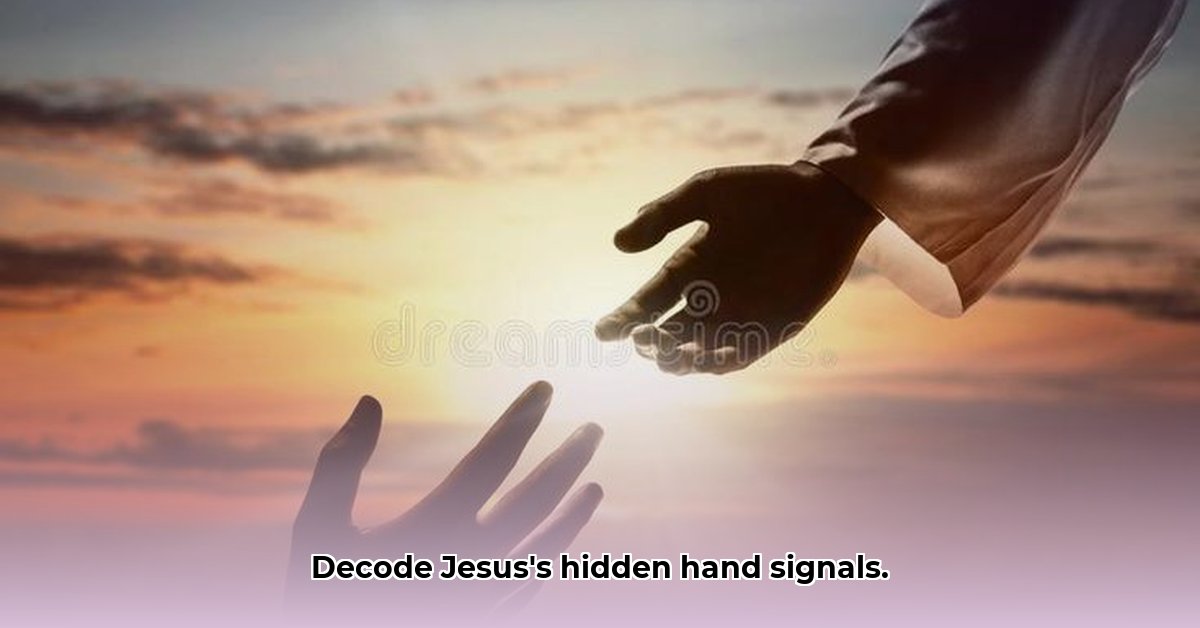Ever notice the way artists portray Jesus’ hands? It’s more than just artistic detail; those hands tell a rich story. From ancient mosaics to iconic Renaissance paintings, the manner in which Jesus’ hands are depicted unveils profound meanings rooted in Christian theology and tradition. This article delves into the symbolic language expressed through these hand gestures – subtle yet powerful signals conveying complex concepts such as the Trinity, the Incarnation, and the divine nature of Jesus Christ. We’ll explore how different periods and art movements have interpreted and represented these gestures, providing a framework for understanding the messages artists sought to communicate. For a deeper dive into Jesus’ teachings, see [Jesus’ Word](https://www.lolaapp.com/jesus-is-the-word/). Prepare to see Christian art with enlightened eyes, appreciating the depth of meaning embedded within these sacred depictions.
Decoding the Symbolism: Jesus’ Hand Gestures Explained
The Silent Storytellers: Gestures in Religious Art
Have you ever considered how much a simple hand gesture can communicate? In religious art, particularly in portrayals of Jesus, hand gestures transcend being mere anatomical details; they function as potent symbols, silently narrating stories across centuries. Consider them visual sermons, meticulously painted or sculpted. What previously hidden stories reside within these hand positions concerning religious iconography and artistic expression? Let’s examine how posture, context, and symbolism converge to create layers of meaning.
The “IC XC” Sign: A Christogram Embodied
A frequently seen gesture involves a specific arrangement of the fingers, often referred to as the “IC XC” sign. Typically, the thumb, index finger, and middle finger are extended, while the ring finger and pinky are curved inward. This isn’t arbitrary; instead, it’s a visual representation of a Christogram, a symbolic abbreviation for the name of Jesus Christ. “IC XC” is derived from the Greek spelling of Jesus (IHCOYC) and Christ (XPICTOC). Consequently, the hand gesture ingeniously mirrors these letters, effectively revealing Jesus’ identity to viewers through a non-verbal, visual code.
Trinity and Incarnation: Divine Mysteries Encoded in Christian Art
Beyond simply identifying Jesus, many depictions of his hands allude to deeper theological concepts central to Christian doctrine. Certain hand positions are interpreted as representing the Holy Trinity – the Father, the Son, and the Holy Spirit – while others symbolize the Incarnation, the belief that Jesus Christ is both fully God and fully human. Subtle variations in finger placement, hand angle, or overall posture can carry symbolic weight, offering hints into profound religious themes. However, it’s important to recognize that these interpretations are subject to scholarly debate and personal understanding, and complete consensus on these theological interpretations of art is not always achieved.
Unpacking the Mystery: A Nuanced Perspective
Interpreting the meaning of hand gestures in religious art is an ongoing and evolving process. The inherent ambiguity and multiplicity of interpretations contribute to the richness and enduring appeal of these artistic representations. Rather than seeking definitive answers, embrace the complexity and allow for multiple perspectives. This uncertainty itself is valuable, reflecting the diverse ways individuals connect with religious art and express their faith. No singular, definitive guidebook exists for interpreting every gesture. Instead, the meaning is highly dependent on context. The artwork’s style, historical period, and the artist’s intent all influence the meaning associated with the art symbolism. A Byzantine icon and a Renaissance painting, though depicting the same gesture, will likely convey different nuances, signifying distinct artistic interpretations.
Time, Place, and Meaning: A Spectrum of Interpretations in Sacred Art
The depiction of Jesus’ hands varies across different art styles and geographical regions, impacting the meaning conveyed. For example, Byzantine art adheres to specific conventions and symbolic language, resulting in gestures that differ markedly from those found in Renaissance art. This variety underscores the importance of cultural and historical context in interpreting visual symbolism. Moreover, even within a single tradition, different groups or individuals may offer varying interpretations. This diversity highlights the richness and complexity inherent in the study of religious art, emphasizing the need for careful observation and consideration of the cultural factors shaping the artwork.
Respecting the Image: Reverence, Not Idolatry
It’s crucial to remember that a depiction of Jesus’ hand, whether in a painting or a statue, doesn’t possess inherent magical powers or divine properties. The image serves as a symbol, representing religious truths and deeper theological concepts, rather than functioning as a literal part of Jesus himself. Understanding this distinction is essential to avoid idolatry, the act of worshipping images or objects as deities. Instead, we should focus on the religious truths and spiritual messages the art seeks to convey, appreciating the artwork as a tool for religious expression and contemplation.
Ongoing Search: Unanswered Questions and Future Studies in Religious Art
The study of hand gestures in religious art is a dynamic field with ongoing research and evolving interpretations. Further investigation is needed to fully understand how these symbolic languages have evolved over time, to discern the various nuances in their interpretation, and to explore their cultural and historical contexts. What future discoveries await us in the field of religious art? How will our understanding of these symbolic gestures deepen and evolve? These are compelling questions that invite further exploration and scholarly inquiry.
A Deeper Dive: Exploring Hand Gestures in Diverse Religious Traditions
While the focus of this discussion has primarily been on depictions of Jesus and Christian art, it’s important to recognize that hand gestures hold significant symbolic meaning across various religious traditions. Buddhist mudras, for instance, are intricate hand positions used to evoke specific states of mind or represent particular spiritual concepts. Similarly, in Hinduism, hand gestures (known as hastras or mudras) frequently accompany devotional practices, dance, and storytelling, conveying a wide range of meanings. Exploring these diverse traditions provides a broader perspective on the universal human impulse to express spiritual concepts through physical actions. This interfaith approach enriches our understanding of the power and pervasiveness of symbolic communication within different cultural and religious contexts.
Visual Context: The Interplay of Elements and Cultural Understanding
Accurate interpretation of religious art goes beyond merely observing the hand gestures themselves; it demands a holistic consideration of the artwork’s overall context. The historical setting, the intended audience, and the prevailing cultural beliefs all play a crucial role in shaping the meaning conveyed by the artwork. Art historians and scholars often analyze the artist’s background, the patron who commissioned the work, and the narrative or theological themes explored by the artwork. This multifaceted approach helps to uncover subtle nuances and deeper meanings that might otherwise be overlooked. For example, a seemingly simple gesture might hold a particular significance within a specific social or religious community, a significance that may be lost or misinterpreted when viewed outside of that context.
This holistic approach reminds us that art is not a static entity, but rather a dynamic form of communication whose interpretation evolves over time and in response to changing societal perspectives. Even seemingly simple gestures can hold layers of meaning, requiring a detailed consideration of the cultural and historical factors surrounding their creation and reception. The meaning is not solely “in the hands” but in the intricate weaving together of artistic expression, cultural beliefs, historical context, and theological understanding.
Recognizing Ambiguity: Acknowledging the Boundaries of Interpretation
Finally, it’s important to acknowledge the limitations inherent in our interpretations of art. While we can analyze gestures, research their historical origins, and propose potential meanings, complete and absolute certainty often remains elusive. Multiple interpretations can coexist, reflecting the rich ambiguity and layered symbolism inherent in religious imagery. Accepting these limitations strengthens our analytical approach, encouraging further investigation and fostering a deeper appreciation for the complexities of religious expression. The journey of interpretation becomes as meaningful as the destination, and the ongoing dialogue surrounding these symbolic gestures ensures continued engagement with the artistic and spiritual narratives they represent.
Unlocking the Code: How to Interpret Jesus’ Hand Gestures
Key Takeaways:
- The depiction of Jesus’ hands in religious art is not arbitrary but rather a carefully constructed language of symbols rooted in ancient traditions and evolving theological interpretations, offering insights into religious symbolism.
- Understanding these gestures requires a thorough exploration of their origins in Greco-Roman rhetoric and their subsequent transformation within Christian symbolism, demonstrating the impact of cultural influences.
- While some gestures have widely accepted meanings, nuances and variations exist, necessitating careful contextual analysis to determine the specific intent and significance within each artwork, emphasizing the need for art historical context.
- Interpreting these gestures also involves a consideration of the historical period, geographical location, artistic style, and the broader context of the artwork from various art movements, enriching our understanding of the cultural and historical factors shaping the artist’s choices.
- Recognizing the potential for multiple interpretations fosters a more nuanced and sophisticated appreciation for the complexity of religious art, moving beyond simplistic readings and promoting art appreciation.
Legacy of Oratory: Gestures as Communication in Religious Art
Have you observed the subtle yet powerful positions of Jesus’ hands in religious artwork? These visual cues are not accidental; they resonate with centuries of communication, drawing inspiration from the Greco-Roman traditions of oratory. In ancient rhetoric, skilled speakers employed hand movements – a practice known as chiromancy – to emphasize their words and engage their audiences. Think of these artistic depictions as a visual language, adding layers of meaning and emotional depth to the narrative scene. In what ways did this ancient practice influence our interpretation of Jesus’ images, thereby enriching both visual communication and artistic interpretation?
The open palm, frequently depicted in images of Jesus, serves as a powerful example. This simple gesture signifies openness, honesty, and a willingness to receive, all communicated through symbolic representation. It is an invitation to faith, carrying profound cultural implications that transcend mere visual appeal. Despite its simplicity, the open palm carries significant weight as a symbol of welcome and acceptance.
The “Blessing” Gesture: Unveiling the Layers of Christian Iconography
Perhaps the most recognizable hand gesture associated with Jesus










